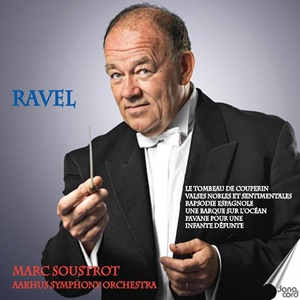
Maurice Ravel (1875-1937)
Le Tombeau de Couperin
Valses nobles et setimentales
Rapsodie Espagnole
Une barque sur l’océan
Pavane pour une infante défunte
Aarhus Symphony Orchestra/Marc Soustrot
rec. 2023, Aarhus, Denmark
DANACORD DACOCD 982 [67]
The competition is intense when it comes to recordings of Ravel’s orchestral works, which are not that great in number in any case. Just recently I reviewed a disc from Ondine, in which Robert Treviño and the Basque National Orchestra gave fine readings of the Rapsodie Espagnole and Une barque sur l’océan (ODE 1385-2). And of course there are the big-hitters such as Haitink, Abbado and Rattle, who have all turned in recordings of the highest quality in this repertoire.
The French conductor Marc Soustrot has been around for many years – he was André Previn’s assistant with the LSO in the 1970s. He has gained the respect of many orchestras and audiences since then, and is now chief conductor of the Malmö Symphony Orchestra, as well as the one based at Aarhus, Denmark, which he leads on this CD.
Every work on this disc started life as written for piano. But with Ravel, you can’t help feeling that he saw many of his piano pieces as ‘sketches’ for orchestral works – their character, in those cases, is only fully revealed in their orchestration (which is not to say that the original piano versions are not well worth hearing).
They begin with Ravel’s tribute to 18th century French music, Le tombeau de Couperin. The players cope well with this very tricky music; but it all sounds a little rushed and breathless – a tiny bit more space would be welcome, though I must emphasise that the playing is sensitive and stylish. More relaxation in those first three movements would also enhance the impact of the jaunty final Rigaudon.
The chain of waltz movements known as ‘Valses nobles et sentimentales’ was written for piano in 1911, then orchestrated the following year. Most of the waltzes are less than two minutes long; the fascination for me is to hear how many hints there are of that extraordinary post-WW1 work, La Valse. That, of course, ends in destruction and disaster, while here Ravel is content to revel in the charm and sexiness of the waltz style. That said, it is incredible just how many moods, colours and characters he finds, and Soustrot and his players bring those features out skilfully.
Rapsodie Espagnole, which follows, is a masterpiece; it’s also a reminder of the importance of the composer’s Basque heritage to him. His mother, to whom he was always so close, was Basque, so it was in his blood, even though his family moved to Paris when he was very young. The Rapsodie’s rhythmic intensity, vibrant colours and sheer beauty bring out the best in these performers, and these are, for me, the outstanding tracks on the disc.
Une barque sur l’océan (A boat on the ocean) is an orchestration of one of the five movements of his 1904 piano suite Miroirs, of which he orchestrated two over the following years (the other being Alborada del gracioso). It gains its evocative power from the employment of short motifs rather than fully-fledged melodies, a subtle use of harmony, and perfectly judged instrumentation.
The final track is a most sensitively played Pavane pour une Infante défunte, with huge credit to the Aarhus orchestra’s principal horn. OK, this is, after Boléro of course, Ravel’s best-known and most recorded music. But there’s a good reason for that; it might be, just might be, the most beautiful melody ever written – by anybody! Well, these players and their conductor certainly make you feel that way, which is how it should be.
So, despite my slight reservations about Le tombeau de Couperin, this is a fine and stylish disc, thoroughly recommended.
Gwyn Parry-Jones
Previous review by John France (July 2024)
Buying this recording via a link below generates revenue for MWI and helps us keep free access to the site



















